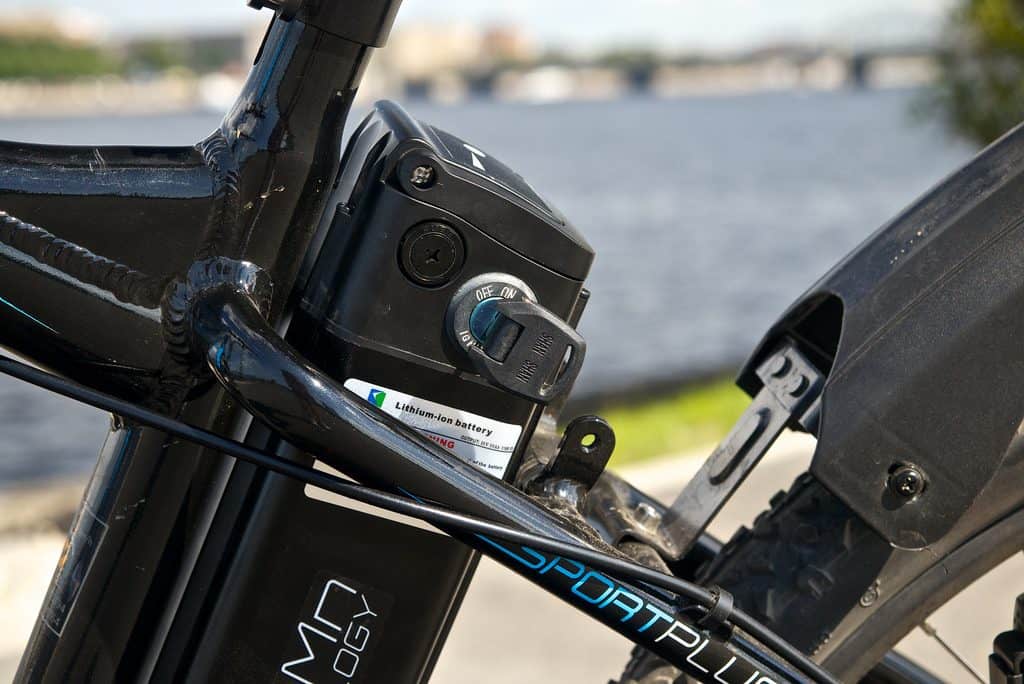Last Updated on January 29, 2024 by Igor Karni

E-bikes bring a lot of undeniable advantages to the table. Being able to serve as a reliable means of transportation without relying on gas is almost always a welcome advantage for most motorists.
Considering the ballooning prices of petrol, you cannot really be surprised by the growing number of people who are switching to e-vehicles. And that is arguably just the tip of the iceberg benefits-wise.
That said, like any other vehicle, it is not devoid of cons too. What are then the disadvantages of electric bikes? Some of the disadvantages of e-bikes include:
- E-bikes are overall pricey;
- Battery has a rather short lifespan;
- Battery charge time is long;
- Charging infrastructure is not well-developed;
- Riding range remains low;
- E-bikes are considerably heavier;
- Maintenance and repairs are costly;
- E-bikes tend to have low resale value;
- E-bike manufacturing remains not environmentally friendly.
Compared to a standard bike, electric bikes usually cost three-fold, especially high-end models. And this is only expected to increase with time. Costs because of a battery replacement are included in this as well. Since most standard e-bike batteries can only run for 2-3 years or so, this can really take a toll on your finances in the long run.
Table of Contents
Factoring in limited riding range and annual maintenance, you can only expect it to increase further. Of course, its downsides are not just limited to personal issues. The production of electric bikes and their batteries has also been proven to be particularly harmful to the environment.
Let us take a closer look at how each of these cons affects the general e-bike riding community. We have dedicated a section for explaining each one for your easy reference.
Disadvantages of electric bikes
Still rather low battery life
If we are going to talk about the primary, the relatively short battery life. And we are not just talking about how quickly the battery drains after every ride here. Rather, it also connotes how soon you will have to ultimately throw away the battery and replace it.
Read also: What are the differences between e-bike batteries? And, How to properly store an electric bike?
The reason behind this could be that its riding range has already decreased significantly. Usually, a 10-mile reduction is already a bad sign that the battery will need to be changed soon. This applies to every ride that you do with its battery fully charged.

Lead-acid batteries were the progenitors of e-bike batteries before they were replaced by their lithium-ion counterparts. And they were replaced primarily because of their short battery life. At best, you can only expect it to last for a year.
Not to mention the fact that plenty of electric bike batteries begin to deteriorate the moment you start using them frequently. By the same token, lead-acid batteries tend to be damaged if you do not use the bike for long periods of time or if you overcharge them.
Read also: What is the difference between e-bike batteries? And, How far can e-bikes go? What is the e-bike range?
This severely affects your running costs if you look at it carefully. For one, most e-bike users may not know it, but they are probably not making the most of their bike’s battery. This is especially true if you calculate the total miles you accrue in the course of a year and then compare it with the estimated battery life of your e-bike.
Nonetheless, lithium-ion batteries have become the preferred option in recent models due to their comparatively longer life and lighter weight. Considering the still-rising trajectory of electric bikes in terms of innovation, it will not be a long shot to expect future models to have longer battery life.
Prohibitive costs: e-bikes are expensive
It is already a given that e-bikes cost way more than your average bike and often even a scooter or motorcycle. Many factors dictate this, such as the fact that its technology still has not peaked yet, and most mid-range and high-end integrate additional features for user convenience.
Read also: How much does it cost to own an e-bike? And, What is the difference between cheap and expensive e-bikes?
They are also able to provide remedies to some of the primary downsides of electric bikes by having a higher battery life and riding range.

Furthermore, this con arguably does not apply to e-bikes in the lower end (such as those costing $600-$700) because they still manage to beat the prices of some petrol bikes. A lot even manage to deliver an all-around satisfactory e-bike experience with each ride.
Read also: Why are e-bikes so expensive? And, What is the difference between cheap and expensive e-bikes? And, Will e-bikes become cheaper?
Long battery recharge time
While this may vary in every model, electric bikes normally take a good while to charge. Most require at least 4 to 6 hours to charge completely. This might not be much of a hassle to riders who can anticipate this with every ride.
But if you suddenly run out of battery life unexpectedly, you would have no other choice but to wait for it to charge. Much worse if there is no nearby platform for you to charge your e-bike in. Would you be willing to push it around with you till you get to the nearest charging station?
Even so, there are already e-bike models that charge significantly faster than others. And it would not be a surprise if certain brands will vigorously try to address this issue in their more advanced models.
Missing or insufficient charging Infrastructure
Unlike traditional bicycles, electric bikes require charging infrastructure to recharge their batteries. In some areas, the availability of charging stations may be limited, which can pose challenges for longer rides or when traveling to unfamiliar locations.
Hefty weight
Almost anyone who has ridden an e-bike will agree that a lot of them are heavier than standard bikes. Lead-acid battery-powered bikes often have this attribute, which takes a toll on speed and the bike’s ability to conquer steeper roads and terrains. If the electric bike does not have speed-boosting capabilities, then this can be a real problem.
Read also: How heavy are e-bikes? And, Can an e-bike pool a trailer?
This is certainly another major problem that manufacturers are doing everything in their power to solve. The introduction of lightweight lithium-ion batteries was one of the first steps companies made. Lighter materials that are also more durable are slowly being incorporated into the body of most e-bikes.
Read also: Modmo Saigon, a 12 kg / 200 km range urban e-bike. And, Vanmoof S3/X3 test and review, finally an ideal city e-bike?

Low riding range
Not a lot of electric bike models can boast of supporting maximum riding ranges that exceed 30 miles (around 48 km). There may be more powerful models that can extend this average. But obviously, you have to expect to pay a larger sum of money for such coveted electric bikes.
If we are to consider highly undesirable scenarios of e-bikes not delivering the exact riding range that was expected from them, this problem’s effect could not be felt more.
Read also: How far can e-bikes go? What is e-bike range on a single charge? And, How fast are e-bikes?
Imagine calculating a trip that will take you 15 miles (24 km) to get to one point and then another 15 miles (24 km) to return to the place where you started. More often than not, e-bikes will not be able to complete this circuit without running out of battery life, as a lot of user anecdotes can attest.
High maintenance and repair costs
The notion of costly maintenance and repair of electric bikes is rooted in a lot of possibilities that might occur and affect the performance of your e-bike. From its motor sensors dying out and needing replacing to LCD screens and other techy features being broken, you will certainly have to have these repaired in order to make full use of your e-bike.
The fact that it can be hard to find a mechanic for your e-bike should a certain part malfunction is another con to be mindful of. You may have to scour the net or your locality just to find a suitable mechanic or repair shop for it, especially if the model is not that well known.
Read also: How to find a reliable e-bike? And, Should I buy a new or used electric bicycle?
However, if it is manufactured by a brand that has close connections with a network of e-bike mechanics, then you are definitely luckier in that regard.
Production still damages the environment
Lastly, the overall manufacturing cycle of electric bikes is actually not good for the planet as a whole. Building electric bikes requires burning coal or fossil fuels, and this has been proven to be not at all environmentally friendly.
Even lithium-ion battery parts are not 100% recycled, so you can expect this problem to compound the more batteries are produced. That is not to say that manufacturers are not actively looking for more eco-friendly methods to create new models.
Read also: Tips before buying an electric bike. And, Are electric bikes good for the environement?
A few words in conclusion
The disadvantages of electric bikes may seem numerous at first glance. However, upon closer inspection, their impact is not nearly as substantial as the advantages provided by these innovative inventions. Yes, the battery life at present may seem subpar, or the riding range may be a bit disappointing in a lot of models.
But why are there users who report being able to save a lot more on an e-bike used for 7 years, with battery and motor replacement and maintenance costs considered and calculated? Simply put, electric bikes still let users save a lot.
Read also: Here is why e-bikes are really cool. And, How to select the best city e-bike (with examples)?
Additionally, regardless of the disadvantages of electric bikes, they still remain reliable vehicles for a lot of people. It can be argued that their advantages, though fewer, simply have no equal. The cost reduction capabilities of e-bikes in terms of running costs are very much their own. And this is simply because it manages to run on electricity. It is quieter too and causes less pollution as far as running one is concerned.
Add to this the consistent drive of pioneers and brands of electric bikes to overcome most of its disadvantages, it is safe to say that an e-bike-dominant world is surely in the making. The more appropriate question would probably be when this will occur exactly. Considering the robust investments flowing into the industry, it will not be a surprise if we begin seeing major improvements in the next 5 years.
Igor is a sustainable mobility and green energy advocate. His mission for Easy E-biking is to help make electric cycling simple, practical, and fun. Follow him on Facebook and LinkedIn.




